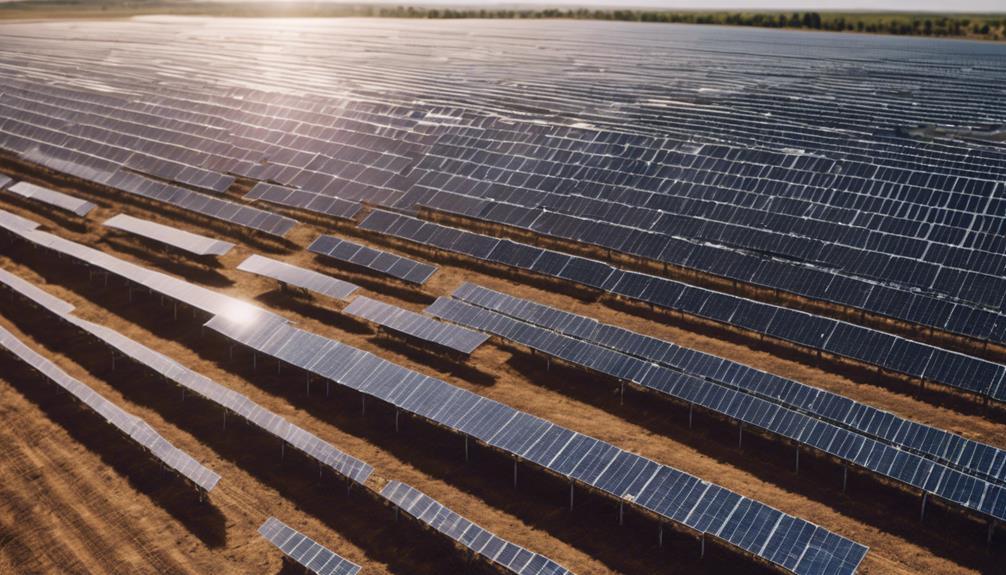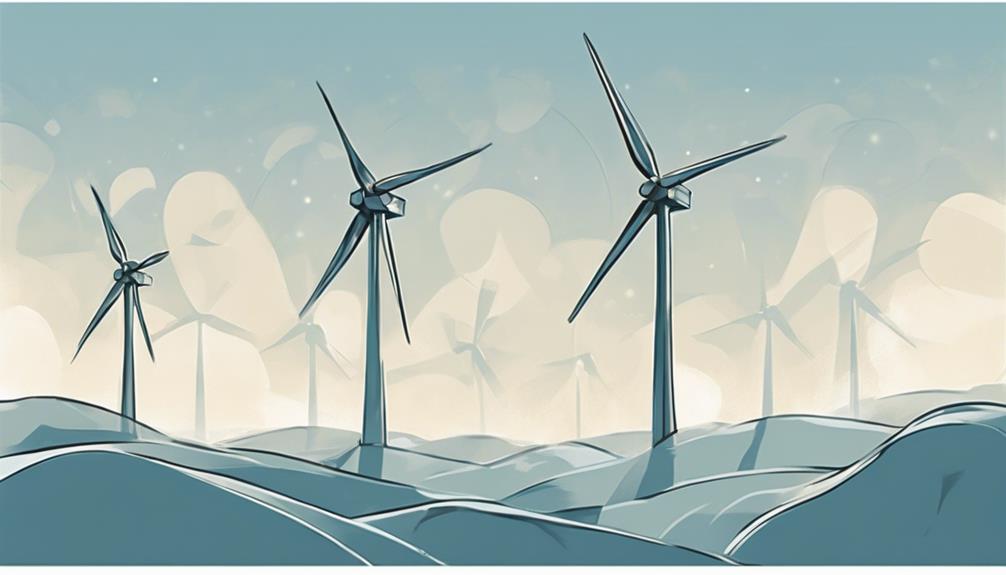Geothermal energy for electricity is captured through dry steam, flash steam, and binary steam power plants. They use steam from underground reservoirs or high-temperature fluids to spin turbines. Enhanced Geothermal Systems are transforming the sector, tapping deep sources for efficient electricity. Low-temperature resources are utilized in binary cycle technology, offering sustainable heating solutions. Abandoned wells can be repurposed for clean energy production, reducing reliance on fossil fuels. Co-production from active wells maximizes resource efficiency for zero carbon footprint electricity. Geothermal can heat buildings, run greenhouses, and industrial processes, lessening dependence on traditional methods. Further exploration reveals more on its diverse applications and environmental benefits.
Key Takeaways
- Geothermal energy is harnessed using dry steam, flash steam, and binary cycle power plants.
- Dry steam plants utilize steam directly from underground reservoirs.
- Flash steam plants transform high-temperature fluids into vapor to drive turbines.
- Binary cycle plants use a closed-loop system with a working fluid.
- Enhanced Geothermal Systems (EGS) tap into deep resources for sustainable electricity generation.
Dry Steam Power Plants
Dry steam power plants primarily utilize hydrothermal fluids in the form of steam for generating electricity.
These plants, like the historic one in Larderello, Italy, have been pivotal in the advancement of geothermal energy since 1904.
By directly utilizing steam from underground reservoirs, such as The Geysers in California, dry steam power plants efficiently produce clean electricity.
They play a vital role in sustainable energy production by harnessing the power of geothermal resources.
The technology involved in these power plants enables the direct conversion of the high-pressure steam into electricity, making them an indispensable component of geothermal energy generation.
With their ability to tap into underground steam reservoirs, dry steam power plants are at the forefront of providing reliable and eco-friendly electricity.
Embracing this method of electricity generation contributes significantly to reducing carbon emissions and promoting a greener energy landscape.
Flash Steam Power Plants

Flash steam power plants efficiently harness geothermal energy by utilizing high-temperature fluids that are transformed into vapor to drive turbines. These plants are integral in converting geothermal resources into electricity through a process that involves extracting more energy by flashing the remaining liquid to vapor, thus maximizing power generation. The vapor generated in flash steam power plants is then used to drive turbines and generators, ultimately producing electricity. By operating at specific pressures, the high-temperature fluids within these plants are efficiently converted into vapor to facilitate the electricity generation process. Flash steam power plants play a crucial role in locations abundant in high-temperature geothermal resources.
| Flash Steam Power Plants | |
|---|---|
| Efficiently harness geothermal energy | Utilize high-temperature fluids |
| Transform fluids into vapor to drive turbines | Convert geothermal resources into electricity |
Binary Steam Power Plants

Binary steam power plants, operating at lower temperatures compared to flash steam power plants, are a key technology in harnessing geothermal energy for electricity generation.
In these plants, a closed-loop system is utilized where geothermal fluid from the reservoir heats a working fluid with temperatures ranging from 225-360°F. The heat transfer causes the working fluid to vaporize and drive a turbine linked to a generator, producing electricity.
Unlike flash steam plants, binary cycle technology allows for the reinjection of water back into the geothermal reservoir after passing through the turbine, maintaining a sustainable process. This method not only maximizes the efficiency of low-temperature geothermal resources but also enables the utilization of enhanced geothermal systems.
Enhanced Geothermal Systems

Enhanced Geothermal Systems (EGS) are revolutionizing the geothermal industry by tapping into deep resources economically.
The U.S. Geological Survey estimates a vast 500,000 MW of EGS potential in the western U.S., showcasing the immense opportunity for sustainable electricity generation.
With advancements in technology, EGS offers a promising path towards expanding geothermal energy production and enhancing economic viability.
EGS Economic Viability
Utilizing deep geothermal resources through Enhanced Geothermal Systems (EGS) demonstrates promising economic viability for expanding electricity generation.
EGS taps into untapped deep geothermal reservoirs, offering a substantial opportunity to enhance geothermal electricity production.
The U.S. Geological Survey highlights the vast EGS potential in the western U.S., estimating around 500,000 megawatts of available resources.
By addressing technical challenges and establishing commercial viability, EGS projects aim to drive the growth of sustainable geothermal electricity generation.
This technology presents a significant chance to reduce dependence on fossil fuels and advance clean energy objectives.
Leveraging EGS not only contributes to meeting clean energy goals but also creates a reliable and environmentally friendly source of electricity.
EGS stands as a promising pathway towards expanding geothermal energy production and fostering a more sustainable energy landscape.
EGS Technological Advancements
By harnessing technological advancements, Enhanced Geothermal Systems (EGS) have revolutionized the extraction of deep geothermal resources for electricity generation.
EGS tap into deep geothermal resources economically by creating artificial reservoirs underground.
The U.S. Geological Survey estimates there's 500,000 MW of EGS potential in the western United States alone, highlighting the substantial opportunity for expanding geothermal energy generation.
EGS technology overcomes technical challenges by accessing heat from depths where traditional geothermal systems fall short.
By developing EGS projects, vast untapped geothermal energy resources could be accessed, aiding in meeting clean energy goals and reducing reliance on fossil fuels.
These advancements in EGS technology showcase a promising future for geothermal energy as a sustainable and efficient source of electricity.
With ongoing research and innovation, the potential for EGS to contribute significantly to the renewable energy mix continues to grow, marking a pivotal moment in the utilization of geothermal resources.
Low-Temperature Resources

You can harness low-temperature geothermal resources for electricity generation through binary cycle technology. This method involves a working fluid being heated by hot water to drive a turbine efficiently.
Additionally, co-produced hot water from oil and gas wells offers further opportunities to power binary cycle systems.
Binary Cycle Technology
Harnessing geothermal energy from low-temperature resources, typically ranging from 225 to 360°F, involves the utilization of binary cycle technology.
In binary cycle systems, the heat from the geothermal fluid is used to boil a working fluid with a lower boiling point than water. This boiled working fluid then turns a turbine to generate electricity without directly using the geothermal fluid itself.
Binary cycle technology is essential as it enables the exploitation of geothermal resources that aren't hot enough to produce steam for traditional power plants. By employing binary cycle systems, electricity generation can be expanded to locations with lower temperature geothermal reservoirs, making geothermal energy a more viable and widespread source of sustainable power.
This technology plays a pivotal role in maximizing the potential of geothermal energy and diversifying the sources of clean electricity available for consumption.
Direct Heat Applications
To utilize low-temperature geothermal resources effectively, direct heat applications are employed, providing sustainable heating solutions for various purposes. Geothermal heat pumps and binary cycle technology play crucial roles in harnessing the potential of low-temperature geothermal energy. Geothermal heat pumps efficiently heat buildings and provide hot water by utilizing the stable temperatures found underground. Direct use applications extend to heating greenhouses, schools, and residential buildings, offering eco-friendly heating solutions. Co-production opportunities also exist, where hot water co-produced from oil and gas wells can be utilized for electricity generation through binary cycle technology. This integration of direct heat applications with low-temperature geothermal resources showcases the versatility and efficiency of geothermal energy in providing heating solutions while also contributing to electricity generation.
| Direct Use Applications | Benefits | Examples |
|---|---|---|
| Geothermal Heat Pumps | Efficient heating and hot water provision | Residential buildings |
| Binary Cycle Technology | Electricity generation from low-temperature sites | Schools |
| Heating Buildings | Sustainable heating solutions | Greenhouses |
| Hot Water | Eco-friendly hot water production | Residential buildings |
| Co-Production Opportunities | Utilizing co-produced hot water for electricity generation | Oil and gas wells |
Co-Production Opportunities
Co-production opportunities utilizing low-temperature geothermal resources present a sustainable method for generating electricity while minimizing environmental impact. These resources, typically below 300°F, can be effectively utilized for electricity production through binary cycle technology. Unlike high-temperature geothermal systems, where direct contact with geothermal fluids is necessary, low-temperature resources allow for the indirect generation of electricity, reducing operational complexities.
One innovative approach involves utilizing co-produced hot water from active oil and gas wells as a low-temperature geothermal resource. By integrating this co-produced water into binary cycle systems, electricity can be generated efficiently while also extending the operational life of oil and gas fields. This dual-purpose utilization not only helps in reducing greenhouse gas emissions but also contributes to the overall sustainability of energy production.
Through geothermal co-production from low-temperature resources, a green energy solution is achieved, aligning with the global push for cleaner electricity generation methods.
Co-Produced Resources

Utilizing hot water from active oil and gas wells, co-produced resources harness heat for generating geothermal energy. This innovative approach not only taps into the Earth's natural heat reservoir but also promotes sustainable energy practices.
Here are three key aspects of co-produced resources:
- Resource Maximization: By utilizing hot water encountered during oil and gas extraction, co-production allows for the simultaneous production of oil/gas and electricity, maximizing the potential of each well.
- Water Recycling: After extracting heat from the hot water, the water is recycled by being reinjected into the reservoir. This recycling process minimizes water wastage and promotes efficient use of resources.
- Low Carbon Footprint: Co-produced resources have a near-zero carbon footprint, making them an environmentally friendly option for generating electricity. This sustainable approach aligns with the global shift towards cleaner energy sources.
Abandoned Well Utilization

Repurposing abandoned wells for geothermal energy production involves pumping water into them, heating it with the earth's natural heat, and using the steam to generate electricity. This innovative method presents a sustainable solution for utilizing existing infrastructure to produce clean energy.
With millions of abandoned wells in the U.S., there's a vast opportunity to increase geothermal energy production through repurposing these wells. By converting abandoned wells into sources of geothermal energy, we can generate electricity in an environmentally friendly manner, contributing to a greener energy mix.
This process not only helps in reducing reliance on fossil fuels but also greatly boosts the overall geothermal energy production capacity. By harnessing the Earth's subsurface heat through abandoned well utilization, we can take a step towards a more sustainable energy future while making efficient use of existing resources.
Co-Production From Active Wells

To leverage the potential of active wells for generating geothermal energy, consider harnessing the heat from hot water encountered during oil and gas production. Co-production from active wells offers a sustainable approach to electricity generation by utilizing the natural heat reservoirs present underground.
Here's how it works:
- Simultaneous Extraction: Imagine a well where not only oil and gas are being extracted but also hot water. This hot water, instead of being discarded, is used to generate electricity through geothermal processes.
- Zero Carbon Footprint: Visualize a process where electricity is produced with minimal environmental impact. By harnessing the heat from active wells, the electricity generated has a near-zero carbon footprint, contributing to sustainable energy production.
- Resource Efficiency: Envision a scenario where multiple resources are extracted efficiently from the same well. Co-production maximizes the utility of active wells by allowing the simultaneous extraction of oil, gas, and geothermal energy, contributing to a more sustainable energy mix.
Direct Use of Geothermal Energy

Geothermal energy offers practical applications through direct utilization in industrial processes and heating/cooling systems. Direct use of geothermal energy taps into the Earth's natural heat reservoirs, providing sustainable solutions for various heating and cooling needs. This method is particularly advantageous in areas where subsurface temperatures are not high enough for electricity generation but sufficient for direct applications.
| Direct Use Cases | Benefits |
|---|---|
| Heating of buildings | Reduces reliance on traditional methods |
| Greenhouse operations | Offers consistent and eco-friendly heat |
| Industrial processes | Lowers operational costs and emissions |
| School heating systems | Provides efficient and reliable warmth |
Investing in Geothermal Future

Investing in the future of geothermal energy holds great promise for sustainable electricity generation and economic growth. The Department of Energy (DOE) plays a pivotal role in funding initiatives like Wells of Opportunity to propel advancements in geothermal technology. These investments are essential for establishing the commercial viability of geothermal energy production and meeting clean energy goals.
Here are three ways investing in the geothermal future can shape the energy landscape:
- Expanding Geothermal Electricity Generation: By leveraging existing oil and gas wells, geothermal electricity generation could witness a remarkable 26-fold increase by 2050, making a substantial contribution to clean energy production.
- Driving Industry Shifts: Geothermal investments not only create clean energy jobs but also support industry transitions towards more sustainable and environmentally friendly practices.
- Enhancing Economic Growth: Investing in geothermal energy fosters economic growth by establishing a reliable and renewable source of electricity generation, reducing reliance on fossil fuels, and promoting a greener future.
Frequently Asked Questions
How to Harness Electrical Energy From Geothermal Energy?
To harness electrical energy from geothermal sources, you must understand the available methods like dry steam, flash steam, or binary cycle systems. Each system utilizes underground resources differently to generate power for electricity production.
How Are Geothermal Resources Converted to Electricity?
Access the power beneath Earth's surface by converting geothermal resources to electricity. Harness steam or hot water from underground reservoirs to spin turbines. Tap into renewable energy and reduce emissions with geothermal electricity generation.
Where Can Geothermal Energy Be Harnessed?
Geothermal energy can be harnessed in areas with underground steam resources like The Geysers in California and Yellowstone National Park. Dry steam and binary steam plants operate at different temperatures, offering significant electricity potential.
How Does Geothermal Work as an Energy Source?
Just imagine the Earth's hidden power, waiting to be released. Harness geothermal energy by tapping into hot water or steam underground. Create electricity through innovative methods like dry steam, flash steam, and binary cycle power plants.
How Do the Costs of Geothermal Energy Plants Impact the Process of Harnessing Geothermal Energy for Electricity?
The costs of geothermal energy plants play a crucial role in the process of harnessing geothermal energy for electricity. While the initial investment for building and operating a geothermal plant can be high, the long-term benefits of low operating costs and minimal environmental impact make it a sustainable energy option.
Conclusion
So, now you know how geothermal energy is harnessed for electricity! It's like harnessing the power of the Earth itself to light up our lives.
With dry steam, flash steam, binary systems, and more, the possibilities are endless.
Keep an eye on the geothermal future – it's an energy source that's as timeless as a classic vinyl record.









